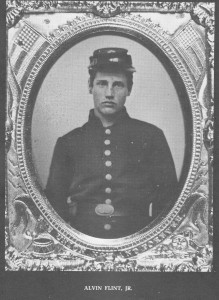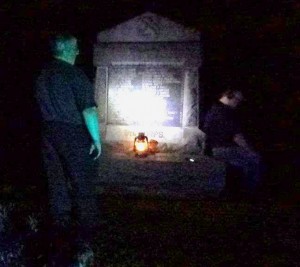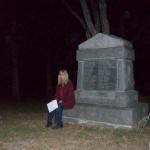“In Like Flint” Contextually Speaking…
Would you ask or command this young soldier to “TURN ON A FLASHLIGHT!” or demand that he “DO SOMETHING!” from a young boy who died for his country?
 ALVIN FLINT, JR., photographer unknown, c. 1861 (McGuire Coll.).
ALVIN FLINT, JR., photographer unknown, c. 1861 (McGuire Coll.).
One of the members of the Eleventh Connecticut Volunteers who fought at Rohrbach (Burnside) Bridge was eighteen-year-old Private Alvin Flint, Jr. Alvin was born in the summer of 1844 to Alvin Flint, Sr., and his wife, Lucy Clark Flint. In 1860, a census taker recorded the following family members: Alvin, Sr., fifty (papermaker); Lucy, forty-nine; Alvin, Jr. fifteen; Evaline, thirteen; and George, eleven. Alvin, Jr., worked at various farms after graduating from school; however, at age seventeen, he enlisted (Private, Company D, 11th Connecticut Volunteers, Hartford, Connecticut). Alvin trained to become a soldier for two years in the Hartford area and this is probably where the above photo was taken. Sadly, when the 11th Connecticut left Hartford to go into the seat of battle on December 16, 1861, Alvin’s mother had died ten days earlier of consumption. Also to add to his sorrow, his sister, Evaline, fifteen, had come down with consumption and she passed away from the disease on January 16, 1862. In the summer of 1862, Alvin, Sr., age fifty-three, was feeling sad and had painful reminders surrounding him in the home of his wife, daughter, and his oldest son in battle, decided to enlist along with his youngest son, George. They enlisted with the 21st Connecticut, Company B. In September 1862, the 21st Connecticut, Company B was shipped out to one of the nearby training camps. Alvin, Jr., was probably aware of this father’s enlistment and it is with an almost certainty that Alvin, Jr., had thoughts of his family before the battle at Antietam. Within the fifteen-minute charge of the 11th Connecticut, Alvin Flint, Jr., was hit by enemy rifle fire and he died near Rohrbach (Burnside) Bridge. While the battle ensued, the stretcher-bearers were unable to reach him during the charge. His father, of course, was devastated. Alvin’s body was sent home and buried. Yet another sad note of the Flint family: late December 1862, both Alvin, Sr., and his son, George, thirteen, both passed away of typhoid fever – first Alvin, Sr., then five days later, George. All are buried in East Hartford’s Center Burying Ground. (From “Antietam: The Photographic Legacy of America’s Bloodiest Day” by William A. Fassanito, Chapt. 10, pp. 231-235.)
 The 11th Connecticut Roll-Call Scenario:
The 11th Connecticut Roll-Call Scenario:
Prior to this scenario, soundmarks were played of bugle calls for assembly. Investigator Bert Richards, posing as a commanding officer, did a roll-call at the 11th Connecticut Monument. Assisting Bert was John Sabol as another officer. Investigator James Castle listened in on the RT-EVP with six-second delay for any responses. On the monument is the list of the names of those that were killed in the line of duty, first assault through the fields that parallel Rohrbach Road at Rohrbach (Burnside) Bridge. Scenario was also enacted in conjunction with the roll call and in relation to Pvt. Lewis Dayton who, based on EOCs, (ethnography of communication, an ethnographic concept) said he knew Pvt. Flint and apparently still interacts with him even after death. Please note the contextual use of a lantern. Here is an example of one of the responses we received after Bert called “Private Alvin Flint”: rollcall flint – aye (credit audio to Investigator Cathy “Cat” Gasch)
(These are reiterative scenarios from which John Sabol previously did a roll-call posing as the commanding officer during the first ghost excavation at Rohrbach (Burnside) Bridge.)
 Private Alvin Flint, Jr., Scenario:
Private Alvin Flint, Jr., Scenario:
This scenario was immediately performed after the 11th Connecticut Roll Call Scenario by Bert Richards. In this scenario, Mary Becker posed as a nurse, and showed the photo of Private Alvin Flint, Jr.. She offered assistance to him or to any of the other fallen soldiers. She articulated to Private Flint that she would compose a letter to his father on his behalf starting with her stating aloud, “Dear Father, I have been shot…” to see what his response would be even though knowing he has passed during the battle. Investigator James Castle was on the six-second delay RT-EVP and Investigator Jonathan Williams on the PSB7 Box. Jonathan Williams did a hard-line to the voice recorder to the PSB7 Box as well as do a hard-line to his ear-buds to eliminate outside interference. Mary noted these following words while composing her note to Flint’s father while Jonathan told her the words being stated by the PSB7 Box: “been shot”, “feels beat up”.
Reading of Surgeon’s Letter to Wife at the 11th Connecticut Monument
Scenario:
After doing a series of scenarios related to the 11th Connecticut with the men portraying various Union soldiers, Mary Becker who portrayed a surgeon’s wife, read a copy of an actual letter from the surgeon to his wife about the battle and where she could mail future letters to him. Investigator Mike Stevenson had an audio recorder and Investigator Gary French was listening on the six-second delay RT-EVP.  There were several women as well viewing this scenario. Much was going on at the time Mary was reading such as women being touched, there were sounds of footfall in the crop of trees, the smell of kerosine, and the camera physically moved. Also, after Mary read the word “home” in the letter, the word “home” is said by a male voice on the audio seconds later. Credit Mike Stevenson with the audio.
There were several women as well viewing this scenario. Much was going on at the time Mary was reading such as women being touched, there were sounds of footfall in the crop of trees, the smell of kerosine, and the camera physically moved. Also, after Mary read the word “home” in the letter, the word “home” is said by a male voice on the audio seconds later. Credit Mike Stevenson with the audio.
***Note: The team is following up on other audio/video/photo recordings to be posted on this website with additional recordings on video/PowerPoint presentations at various lectures by John Sabol in the USA and abroad.
***Further Note: The photos posted while doing the scenarios were lightened and cropped.
